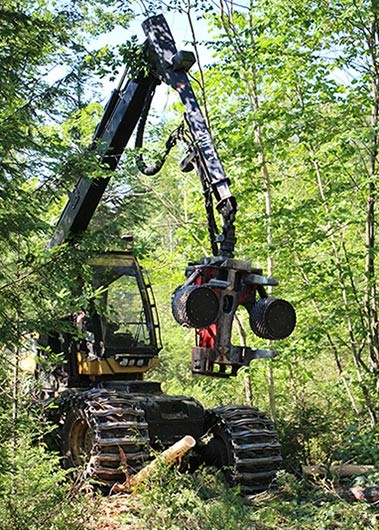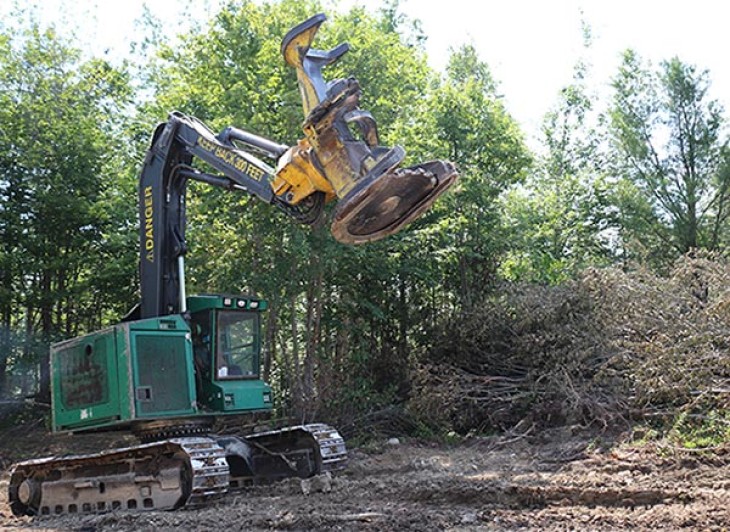Spend time in northern Maine, and you’ll likely get an earful of two seemingly incompatible complaints. The first is the scarcity of jobs. The shuttering of the Verso mill in Bucksport last December comes up frequently in this context – one of a string of closures and consolidations that has reduced paper production in the state. Although the economic news isn’t all bad – the planned expansion of the St. Croix Tissue plant in Washington County, for example, is expected to create about 80 more jobs – there’s a continued sense of loss, seasoned with more than a little resentment of state investments in richer, more densely populated counties along the coast.
A second complaint is that there’s a shortage of people going into the logging profession. It’s tempting to fall back on the “kids don’t want to work hard” explanation for this trend, and indeed I heard a few entertaining riffs on that theme in a recent Maine TREE Foundation tour in Aroostook and Washington Counties – but even if no one in their twenties ever left their mother’s basement, this just doesn’t add up. You’d think that if the jobs were there, and the usual laws of demand and supply applied, there would be plenty of former mill workers and other people, eager for work.
So why the gap? According to Dana Doran, the executive director of the Professional Logging Contractors of Maine (PLC), one factor is the mechanization of timber harvesting, which creates a technological barrier to entry for new recruits. He said that 2014 saw the first growth in logging jobs in Maine in the last seven years, yet members of his association are reluctant to hire to meet new demand because of the “exorbitant costs” of training new employees to operate expensive, complicated machines.
This perspective was echoed by a logger I spoke with, who (after complaining about today’s idle youth) described how quickly you can lose money on a rookie. When you’re operating under thin profit margins, and you’re relying on the efficiency you get from using a $600,000 tree delimber, there’s just not much room for error. It takes time to train someone to use these machines effectively, and in the meantime, the quality of the customer’s job may be compromised. Added to that, there’s the risk of damage and down time for your machine.
Doran’s group is trying to address the recruitment issue by developing a mechanical harvesting operators training program. This effort, funded in part by a two year, $500,000-a-year grant from the state, will accommodate 12 students at a time and rotate among community colleges in three of the most heavily harvested regions in Maine. Details are still being worked out, but class will most likely start in January at the Eastern Maine Community College’s satellite campus in Millinocket.
Doran described a rigorous program. Over a twelve week, 480-hour course, the students will receive instruction on machine maintenance, safety and business management basics, as well as an introduction to forestry and BMPs. They will practice operating a feller buncher, stroke delimber, and grapple skidder, all donated by Caterpillar. At the end of this experience, those who aren’t “weeded out” will receive a certificate that, in theory, will make them much more attractive hires to established logging companies. (While they’re planning to screen candidates carefully for mechanical aptitude and commitment, Doran still anticipates some attrition.) Doran estimates that an entry level machine operator makes around $35,000, plus overtime, and base pay progresses fairly quickly upwards from there, into the $50,000 to $70,000 range for an experienced operator.
Of course the program won’t address other reasons that logging may have recruitment challenges, including the daunting capital requirements for anyone who wants to buy their own machinery. It will be interesting to watch how the program progresses over the next year, however. If successful, it may offer lessons for forest industry boosters in other states. Vermont’s Working Lands Enterprise Initiative has, in a smaller way, also recently invested in operator pre-employment training, with a $53,000 grant to the Cold Hollow Career Center in Enosburg to teach cut-to-length harvesting skills using a simulator.





Discussion *